| Bhutan's
glaciers and glacial lakes: : Lunana |
 |
Bhutan Glaciers - Glacial Lakes |
|
 |
Bhutan Glaciers - Glacial Lakes |
|
|
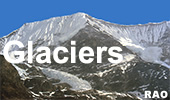 |
|
Lunana's
glacial lakes: Thorthormi Tsho |
|
Thorthormi
lakes
|
 |
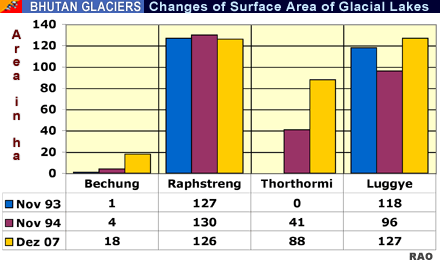 |
| The Thorthormi lakes (picture) do not appear in the 1960s maps of the Thorthormi glacier.
These supraglacial lakes began to appear on the maps only after 1967. After
1993, many supraglacial lakes became visible, and currently this large
glacier contains many supraglacial lakes many of which are merging and
growing. The largest of the lakes is Lake Thorthormi Tsho. |
|
While
it does not appear on the 1958 topographic map, some supraglacial lakes
are visible on the map reported later by Gansser.
The Thorthormi terminal moraine (with a width of 30m at its crest) acts as
a dam between Lake Thorthormi Tsho and Lake Raphstreng Tsho. LakeThorthormi
Tsho is a supraglacial lake that is 65m higher than Lake Raphstreng Tshoand lies directly above it. It is separated from the Pho Chu by a thin,
continuously eroding, left lateral moraine. Since Lake Thorthormi Tsho is at a higher elevation than Lake Raphstreng Tsho, and since the terminal
and left lateral moraine are narrow and unstable, this lake and glacier
need to be continuously monitored.
Source:
ICIMOD, International Centre for Integrated Mountain
Development 2008
Extract
of Impact of Climate Change on Himalayan Glaciers and Glacial Lakes: Case
Studies on GLOF and Associated
Author(s):
Bajracharya, S. R.; Mool, P.; Shrestha, B. 2007 |
 |
top
|
Thorthormi mitigation project |
 |
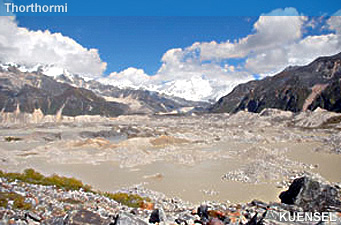 |
| Thorthormi lake (left) and Rapstreng separated by the moraine dam |
Within the last three years since work began on the Thorthormi mitigation project, about 50 percent of the total Nu 130M allotted for the purpose, has been spent.
The lake mitigation project manager, Dawchu Dukpa said about Nu 5M was spent in 2008 purchasing equipment and tools required for engineering and excavation works at the site.
|
|
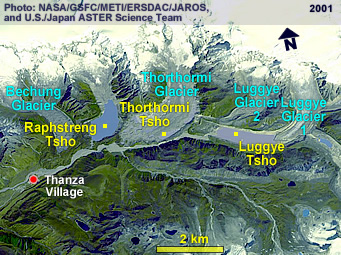 |
| Apart from that, he said, the study they had conducted of the lake some time between late 1995 and early 2000 had to be reassessed with a group of experts from abroad.
"So much time had elapsed since the first study and we wanted to find out the possibility of better excavation sites," Dawchu Dukpa said, adding the intention was to start work on the mitigation of the lake following a detailed survey of it in 2008.
"But it just wasn't possible," he said.
|
|
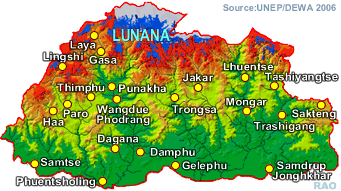 |
| The real mitigation works on the lake began in 2009. The project spent about Nu 26M for transportation of equipment to the campsite at Thanza, and monthly transportation of ration for the workers, including their salary.
This year, the project spent around Nu 30M, leaving it with close to Nu 70M of the total fund allocated.
|
|
Although the four-year project ends next year, the remaining amount, project officials said, was enough to squeeze in a space for one more year, should they fail to achieve their target of reducing the water level to five metres by next year.
"We have enough justifications to get the project board approve of an extension," he said, adding that in 2009, the project was delayed by more than a month after it was struck by a cyclone; while this year the continual rain until September 24 and death of a few workers caused two months delay.
"Had it not been for these calamities we'd have reduced the water level in the lake by at least two metres in each year," Dawchu Dukpa said. "The possibility of achieving this target is still good, as long as the factors are favourable."
He clarified the total amount of money for the mitigation project came from the least developed country (LDC) fund, an accumulation of contributions from various rich nations.
"The global environmental fund only facilitates, while the UN development program coordinates between us and them," he said.
Dawchu Dukpa said the fund contributed an overall USD 3.45M for the mitigation project, while the Austrian development corporation injected USD 800,000 and WWF USD 30,000.
"This year the Larsen and Toubro company, working on the Punatsangchu project, gave us Nu 200,000 to buy workers' gumboots," he said.
The whole money, he said, was split into three components of the project – mitigation, which was allotted USD 2.7M, of which USD 1.3M has been used, USD 900,000 for installing early warning system to be ready by mid-next year, and USD 400,000 for creating awareness on climate change and disaster risk and management.
| Contributed by Samten Wangchuk, KUENSEL, Bhutan's National Newspaper, November 2010 |
 |

|
|
WWF Video
|
 |
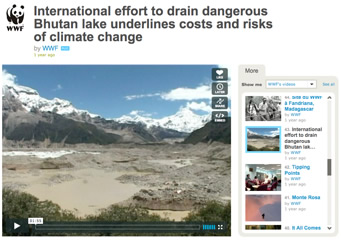 |
 |
 |
External
links |
 |
 |
External
links |
| 29.6
MBPDF-File |
 |
|
top
|
Documents |
 |
|
Regional
Challenges and Local Impacts of Climate Change on Mountain Ecosystems and
Livelihoods |
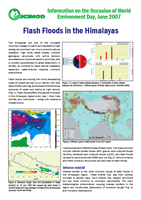 |
| 1.1
MB PDF-File |
 |
| 244
KB PDF-File |
 |
|
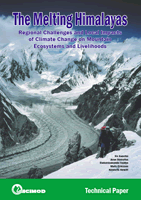 |
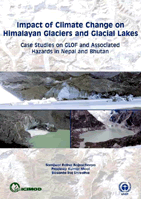 |
| 3.9
MB PDF-File |
 |
Case Studies
on GLOF and Associated Hazards in Nepal and Bhutan (2007)
This
study, prepared in close cooperation with and supported by the United Nations
Environment Programme Regional Office for Asia and the Pacific, investigates
the impact of climate change on glaciers and glacial lakes in two major
glacial hotspots in the Himalayas: the Dudh Koshi sub-basin in the Khumbu-Everest
region in Nepal, and the Pho Chu sub-basin in Bhutan. |
|
 |
top
| Information on Bhutan |
 |
| Links |
 |
 |
 |
External
links |
 |
 |
 |
 |
 |
| GRID-Arendal
News |
NASA's
Global Change Master Directory |
United
Nations Environment Programme |
World
Glacier Monitoring Service |
International
Centre for Integrated Mountain Development |
| Japan international cooperation agency (JICA) |
 |
 |
 |
 |
|










